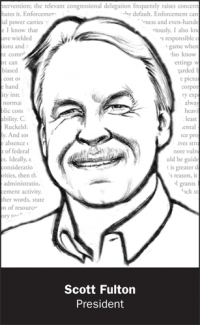Oil Spill Kicked Off Anti-Pollution Era
“In 1969 the signs of . . . concern were everywhere,” writes John Quarles, EPA’s first deputy administrator, in the opening chapter of his invaluable memoir Cleaning Up America. These signs “were manifest in the outcry against the Santa Barbara oil spill,” which happened on January 28, 1969, just eight days after Richard Nixon’s ascent to the White House. There followed in close order a series of epochal events every month of that year. “Suddenly, in cities across the country, citizen environmentalists campaigned. . . . People were demanding a change in the old policy toward the nation’s resources.”
Welcome to our year-long celebration of the dawn of the environmental era, via a series of columns on the events of exactly a half century earlier.
We began in the last issue, with the Christmas 1968 creation of the Apollo 8 “Earthrise” photograph that was the first view people ever had of their whole planet, beautiful as a thin fragile shell of life against the foreground of the bone-dead moonscape. We will build toward the 50th anniversary celebration of the passage of the first modern environmental law, the National Environmental Policy Act, and the creation of the Environmental Law Institute the same day to help the new field grow.
“The year 1969 was truly a watershed year,” agrees Daniel A. Vallero in his revealing book Paradigms Lost: Learning from Environmental Mistakes, Mishaps, and Misdeeds, beginning when “a major oil well off the coast of Santa Barbara, California, blew out, spilling almost a million liters of oil and depositing tar onto approximately 50 kilometers of beach.” It was a disaster of biblical proportions, a sea coast painted black, and “a significant impetus to the environmental movement.”
The spill was definitely a result of human agency. Union Oil’s Platform A off the southern California coast was allowed to continue to pump crude by the U.S. Geological Survey, which “had given approval to operate the platform using casings that did not meet federal and California standards.” Oil platform workers struggled for 11 days to contain the surging spew of crude, as a slick 2,000 square kilometers in extent covered the ocean, much of it eventually washing up on the shore.
Dolphins died by the score, their blowholes contaminated. Birds were coated with oil; desperate crews worked to clean them, making national headlines, but less than a third of the treated birds survived. Detergents used to disperse the oil from the sandy beaches proved toxic to wildlife, worsening the toll. But Union Oil President Fred Hartley was sanguine: “I don’t like to call it a disaster, because there has been no loss of human life. I am amazed at the publicity for the loss of a few birds.”
In Washington, President Nixon watched the media coverage. The oil spill had become the major news story nationally, as the three major networks flooded the zone with 50 reporters, and members of Congress arrived to demand action. The day after the slick washed ashore, Nixon announced a complete cessation of drilling in federal waters off the California coast.
The oil spill provided nightly news coverage, with the desperate volunteer crews struggling to save wildlife and to steam-clean their beaches. On March 21, the president signalled he had had enough — he visited the site of the spill. Nixon flew in a helicopter over the large extent of the slick. He then landed on the beach of Santa Barbara, where he held an impromptu meeting with local residents that was heavily covered by the press. “The Santa Barbara incident has frankly touched the conscience of the American people,” Nixon told the crowd, promising a federal response.
According to Quarles, Nixon’s response to the Santa Barbara oil spill was to kick off a White House anti-pollution campaign that would be popular with the public. The incident did not ultimately produce a nationwide drilling ban, nor did it even end oil rigs off the California coast. But it was the first use of the 1968 National Contingency Plan for hazardous releases, showing that a governmental response to industrial pollution could be welcome. And three years later Congress protected all the “waters of the United States,” including the near-shore oceans, in passing the Clean Water Act overwhelmingly over Nixon’s veto. Why the president turned against a law he largely spawned is another story.
Notice & Comment is written by the editor and represents his views.
"Carbon dioxide is being added to the earth's atmosphere by the burning of coal, oil, and natural gas at the rate of 6 billion tons a year. By the year 2000 there will be 25% more CO2 in the atmosphere than at present. This will modify the ehat balance of hte atmosphere to such an extent that marked changes in climate, not controllable through local or even national efforts, could occur."
— From “Restoring the Quality of Our Environment,” 1965 report to President Lyndon Baynes Johnson
Commercial Fishermen Sue Big Oil Over Emissions and Oceans
Commercial fishermen in California and Oregon sued dozens of oil and gas companies . . . for hurting the fishing market in the Pacific Ocean by raising temperatures on Earth.
The Pacific Coast Federation of Fishermen’s Associations is seeking financial compensation for its losses from 30 companies, including oil and gas supermajors, according to the suit filed in a California state court.
“It’s industry to industry, one harming another with the causal connection to prove it,” Noah Oppenheim, executive director of PCFFA, said in an interview. “Certainly we believe that the merits of the case are pretty clear and self-explanatory.”
Defendants in the case, including Exxon Mobil Corp., Chevron Corp., BP PLC, Royal Dutch Shell PLC and ConocoPhillips, have known for almost 50 years that burning fossil fuels warms the planet, the plaintiffs said.
Algal blooms, which can lead to a buildup of domoic acid in crabs, are scientifically tied to warming oceans. Because the acid is dangerous to people, human-caused warming is directly threatening the fishing industry, said Oppenheim, who has degrees in marine biology and marine policies.
“If the fishermen were causing this much harm to the public, we should get shut down,” he said.
— E&E News
An Update on Last Issue's Lead Feature
Juliana v. United States has been called the most important environmental case of the century. The 50-day trial was slated to start on October 29 in federal district court in Oregon, about the time our issue with coverage of the pretrial jousting hit the mail. However, the youths’ climate lawsuit was stayed by the Supreme Court. On October 19, Chief Justice Roberts issued an order that stopped the case until the plaintiffs responded to a Department of Justice motion to dismiss because the government argued that the complaint was overly broad, and that climate policy shouldn’t be decided by the judiciary.
DOJ asked for a rare writ of mandamus to stop the proceedings and argued that “In contrast to the obvious harms to the government, respondents can make no credible claim of imminent, irreparable harm. . . . Their alleged injuries stem from the cumulative effects of CO2 emissions from every source in the world over decades: whatever additions to the global atmosphere that could somehow be attributed to the government over the time it takes to resolve the pending petition are plainly de minimis.”
On October 22, the youths responded to the Trump administration’s application for a stay. Among other things, the plaintiffs argued that contrary to the assertions of the Trump administration, the trial would not intrude on the ability of the executive branch to carry out its functions and that there would be no confidential information disclosed. Moreover, they pointed out that the projected 50-day length of the trial and its costs were not enough to show irreparable harm to the government for purposes of a stay.
Importantly, the youngsters argued that Juliana is not an environmental case per se; instead, it is a civil rights case. The issue is not about the federal government’s failure to act on the climate. Rather, the kids asserted that it is through its affirmative decisions that the federal government created a national energy system that caused climate change that now deprives them of their constitutional rights to life, liberty, and property. Thus, the plaintiffs argued, the decision does not hinge on a newly recognized unenumerated fundamental right and that DOJ thereby has purposely misstated the essence of their case.
On November 2, Roberts issued an order lifting the stay and denied without prejudice the Trump administration’s petition for a writ of mandamus. Consequently, DOJ filed a motion for a temporary stay of the trial and another petition for a writ of mandamus with the 9th Circuit. The appellate court issued an order giving the youth plaintiffs 15 days to file a response to the government’s petition. The 9th Circuit also provided the opportunity for District Court Judge Ann Aiken to address the petition for mandamus within the same time window. Moreover, the youngsters and the Trump administration were ordered to file a joint report on the status of discovery and any relevant pretrial matters.
On November 21, Aiken stayed the case until the 9th Circuit issues its decision. She also certified her prior orders in the case for interlocutory appeal. It appears that the trial is unlikely to start in the very near future.
From a procedural point of view, this is “no ordinary case,” to quote the trial judge. The U.S. government apparently believes that this lawsuit is a judicial usurpation of power. The Trump administration has filed, thus far, four petitions for a writ of mandamus with the 9th Circuit, and two petitions with the Supreme Court. But the legal requirements of mandamus will typically not be granted if adequate relief can be obtained by some other means — such as an appeal.
Juliana v. United States has been stayed but not stopped.



